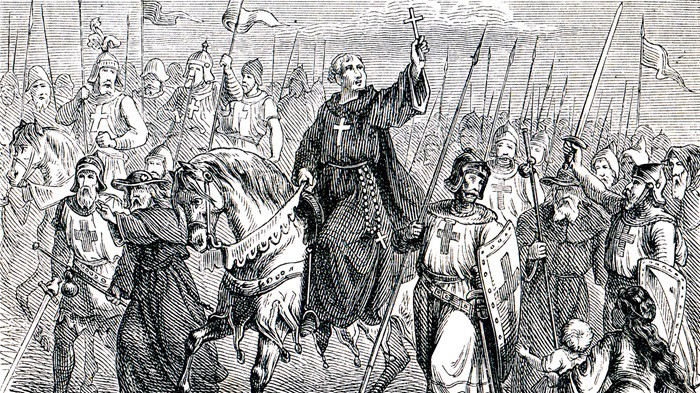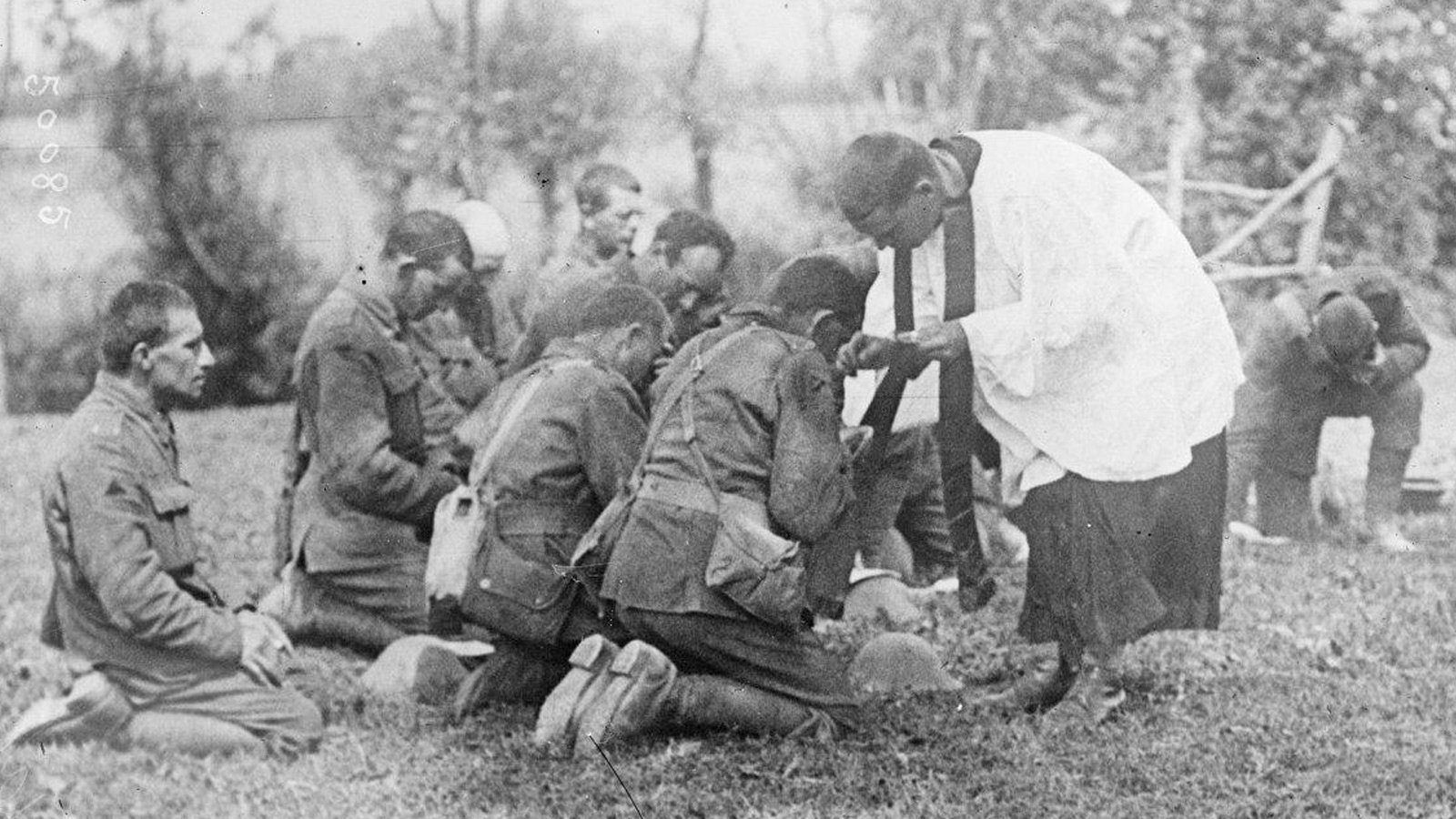17th Century Jesuits in New France
French exploration into what would later become New France (and which would eventually become Canada) began in 1534 with Jacques Cartier. In 1540, King Francois I announced his intention to establish a colony in order to exploit the resources of the area, and justified this colony in religious language and with the idea of bringing new souls to their god. As with other European countries, the French did not acknowledge any validity to aboriginal religions, possible land ownership, and ability to govern themselves. Under the Discovery Doctrine-a legal doctrine stating that Christian monarchs had a right, and possibly an obligation, to rule all non-Christian nations-the French assumed that their religion and government was superior to the religions and governments of the Native Americans.
The Company of New France, a joint stock company modeled after the English and Dutch companies trading in the East Indies, was given a royal charter in 1602. This charter included exclusive trading rights from Florida to the Arctic Circle and westward along all rivers flowing into the “Fresh Sea” (the Great Lakes). In exchange for the trade monopoly, the Company promised to settle 4,000 colonists in New France over the next 15 years. The Company was also to see to the conversion of the natives.
One of the first missionary groups to begin working with the Native peoples in New France was the Jesuits. The Jesuits are members of a Catholic male religious order known as the Society of Jesus. The Jesuits, who are sometimes called “God’s Marines,” have a reputation for accepting orders to live and proselytize anywhere in the world, even under extreme conditions.
The Jesuits arrived in New France in 1611 and began to learn the native languages as a way of carrying their message to the people. The Indians found the Jesuits to be different from the other Europeans they had encountered as they did not seem to want land, furs, or women. They only wanted to live in an Indian household so that they could learn the language. Initially the Jesuits, who were often called Blackrobes, were well-liked because of their quiet manners. However, the Indians considered them to be poorly educated and perhaps somewhat retarded as they had little understanding of the spiritual world.
As the Jesuits were learning the Indian languages so that they could begin their spiritual mission, France was making plans to send more colonists and to redeem more souls for the Church.
In 1625, three Jesuit priests and three lay brothers arrived in New France. They were financed by Henri de Lévis, duc de Ventadour. Father Charles Lalemant, former professor of grammar, literature, and mathematics at the Jesuit college in Paris, is placed in charge of the mission. Later historians would call this small group of determined, disciplined, highly trained, and militant members of the Society of Jesus the shock troops for conversion. The French merchant in the colony, however, did not welcome the Jesuits as they feared that converting the Indians would interfere with the fur trade.
Two years later, the Compagnie de la Nouvelle France (Company of the 100 Associates) was organized and sought a royal charter giving it a fifteen-year monopoly on all commerce except for fishing in New France. The charter excluded all religions except for the Catholic Church. The Jesuits were given the position of spiritual advisors to the colonies and the Récollets, who had also had missionaries in the area, were banned. The investors in the company acted more out of religious devotion and patriotism than out of a concern for profits. The investors, as well as the King and his ministers, envisioned the creation of a Catholic French society in which the Native people would be molded by French ideals.
All of the furs were to be sold to the company’s agents and the profits from this enterprise were to be used to sustain the Jesuit missionary efforts. Unlike the Récollets, the Jesuits saw no advantage in assimilating the Indians into French culture. They did not wish to alter Indian culture any more than was necessary for them to convert to Christianity.
In 1631, the Jesuits in New France began publishing an annual report on their missions. These reports can be considered to be “truthful” propaganda which fed French curiosity about the Indians and the New World.
In 1634, the Jesuits increased their missionary planning. According to their revised plan, missions were to be opened among the major native groups beginning with the populous and centrally located Hurons. In addition, Jesuit residences were to be established at Quebec and Trois-Rivières, and natives were to be encouraged to settle near them for instruction in everything from agriculture to Catholicism.
In 1634, the Jesuit missionary Father Julien Perrault described the unique culture of the Mi’kmaq. In his report he told how they live with the seasons, how they dressed and behaved, and what they looked like. Reflecting his Jesuit bias, he reported that
“what they do lack is the knowledge of God and of the services that they ought to render to him.”
In 1637, Pope Urban VIII threatened excommunication for Catholics who deprived native peoples of their property or freedom. All of the European powers, however, simply ignored this edict.
Unable to cure the Huron of smallpox, the shaman Tonneraouanont lost face among his people in 1637. When he broke his leg and died from the resulting infection, the Jesuit Jean de Brébeuf assigned the calamity to evidence of the power of the Catholic God and attempted to assume the role of tribal shaman. While the Huron viewed the Jesuits as powerful shamans, many felt that the Blackrobes were responsible for the deaths. From the Huron viewpoint, the Jesuits engaged in incomprehensible rituals which seemed to be causing death among their people. Many Huron leaders called for the execution of the Jesuits as evil shamans. However, the desire to maintain good trading relations with the French was stronger than the desire to kill the Jesuits.
In 1639, the Jesuits built Sainte-Marie as a special compound and headquarters for their mission work. The Jesuits appeared to maintain a favorable attitude toward Indian religions. They recognized certain concepts that might be comparable between Indian religions and Christianity and used these in converting the Indians.

A 1638 map of New France is shown above.
In 1640, the Jesuit mission at Sainte-Marie was staffed with 30 men, 15 of which were priests. From this headquarters new missionary expeditions were to be sent out.
In 1640, the Jesuits established a mission among the Nipissing. All of the sick children whom they baptized recovered, which seemed to show that the Jesuits had great power and their missionary efforts were relatively successful. Two chiefs-Mangouch and Wikassoumint-also converted.
In 1641, the Jesuit mission to the Mi’kmaq on Cape Breton Island was closed as the native population had dwindled. The Jesuits decided that Cape Breton was not a productive area for teaching and conversion and the missionaries were sent inland.
Montreal was founded in 1642 with great enthusiasm and hope by its devout and zealous backers, les Messiurs et Dames de la Société de Notre-Dame de Montréal pour la conversion de Sauvages de la Nouvelle France. They hoped to create a New Jerusalem, blessed by God, and composed of citizens destined for heaven. The Jesuits labored diligently among the Indians with the intent of incorporating them into this community.
By 1646 there were about 500 practicing Huron Christians. The Jesuits were using a number of different methods to get the Huron to convert. The Jesuits consciously attempted to impress the Hurons with their technological superiority and greater knowledge, including the ability to predict eclipses. There was also a practical side to conversion from the Huron perspective. They had discovered that Christians were treated better than were non-Christians when they traded with the French, and they were also paid higher prices for their furs.
By 1648, Christians had become a majority in the Huron village of Ossossane. While the Christians in this village had been free to behave as they wished when they had been a minority, the Jesuits now directed them to forbid non-Christians the right to practice their traditional religion if they wished to remain in the village.
By 1649, there were 18 Jesuit priests and 30 of their assistants working among the Huron. The Jesuits reported that thousands had been baptized.
In 1665, the Jesuits persuaded a group of Oneida to settle alongside several French families at La Prairie, thus establishing the Indian community of Caughnawaga. Among the Oneida was Catherine Gandeaktena, an Erie woman who had been captured by the Oneida. She had converted to Catholicism and was influential in persuading others to convert.
The Jesuits sent Fathers Jacques Fremin, Jean Pierron, and Jacques Bruyas out to evangelize among the Mohawk and Oneida in 1667. They reported:
“The whole country of the Iroquois was at that time so overcome with fear of a new French army that for several days fourteen warriors had been constantly on the watch…But, by the great good fortune for them and for us, instead of being enemies to them, we were Angels of peace”
In 1667, the Jesuits also traveled to other parts of New France. In Ontario, they established a mission to convert the Ojibwa. Jesuit Father Claude Allouez visited the Nipissing at Lake Nipigon. He found a number of Christian Indian families who had not seen a missionary for nearly 20 years.
In that same year, Father Allouez contacted the Plains Cree in what is now Saskatchewan. He characterized them as being kind, docile, and more nomadic than other tribes. They lived by hunting and gathering wild rice. Two years later, Jesuit Father Dablon tried to convert the Plains Cree. However, as they were nomadic, it made it difficult to convert them.
In 1697, the Jesuits established a Huron community near the fall of the Saint Charles River in Quebec. A chapel honoring Our Lady of Lorette was constructed. In the new community, the Huron continued to live in longhouses and agriculture remained in the hands of the women. The men contributed to the defense of New France by continuing to fight against the Iroquois Confederacy.


